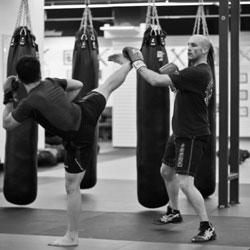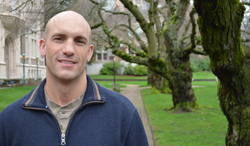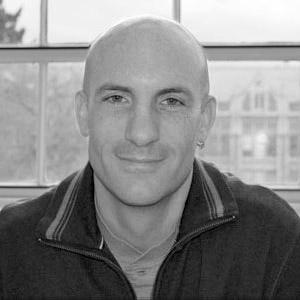Glen Duncan found his passion in exercise – the perfect medicine, he says, to prevent a range of health woes. He teaches Physical Activity in Health and Disease, the only course on campus of its kind. And he's conducting potentially groundbreaking research on the links between exercise, the built environment and chronic disease.
Were you a jock growing up?
Yeah. I was always interested in sports. As a kid I remember playing football or baseball with my friends almost every day. I did track in high school and continued to run in road races throughout grad school. It was always a part of my life.
What's your exercise routine now?
I'm just a fiend. I exercise daily. It's part of my fabric. Martial arts is my main form of exercise. I like running, lifting weights, and I'll do the elliptical machine on the days I can't run because my knees are bad.
How did you turn passion for exercise into a career?
In graduate school, exercise physiology really grew on me. After my master's, I wanted to work at the Olympic training center in Colorado Springs with elite athletes. But my mentor at Ball State University got a call from some folks in Tennessee who were looking for grad students to do TAs. It was serendipitous. I took the chance, drove down to Knoxville, and enrolled at the University of Tennessee. During that time I realized that I wanted to combine research and teaching.
What brought you to the UW?
I was reading a lot of research papers coming out of the UW, and I thought, I should be writing papers with these folks! I came out for a conference and kind of fell in love with Seattle. I feel fortunate to be here. This is the pre-eminent public research university in the country. The collegial atmosphere is really outstanding. I'm sure that I couldn't survive without it.

Thai-style kickboxing, Glen Duncan at right
What do you tell students about exercise and health?
It is medicine, and prevention is absolutely the best medicine. We've basically known exercise is good for us since we've been walking upright. It's good for us in so many respects: preventing cardiovascular disease, metabolic disease, and ameliorating joint and bone conditions. Cancer-prevention linkages are being established now. Exercise affects our cognitive health, depression, anxiety and stress. It hits a lot of things.
And yet not enough of us take this medicine. Two-thirds of adults are overweight or obese. What's the best strategy for improving our health?
I'm not so keen on behavior change alone anymore. It doesn't really work. We can tell people to go out and get their 150 minutes per week of moderately intensive exercise, eat their fruits and vegetables, and reduce their saturated-fat intake, till we're blue in the face. But if the world around us doesn't support these behavior changes, how's it going to happen? I'm now more interested in the environmental- and policy-level determinants of physical activity and diet. You've got to change the real-world settings and then go back to the person, then behavior change has a chance at working.
HIGHLIGHTS
- MS Exercise Physiology, Ball State University, 1994
- PhD Education (Concentration in Exercise Science), University of Tennessee, 1997
- Former faculty and postdoctoral researcher, University of Florida (1998-2003)
- Teaches: Research Design and Physical Activity in Health & Disease
Can you give us an example?
Cigarette smoking is the biggest one. We established a rock solid science base on the health hazards of smoking. Then things happened. It became less desirable to smoke. Policy came in. Cigarettes got more expensive; there was a tax. Smoking was banned in the workplace, then in public places. Quit-lines were set up and nicotine patches sold. It was a whole, concerted effort. Behavior change alone didn't work initially, but then the environment and policies changed in such a way that supported behavior changes and the prevalence of smoking was reduced in the population. The challenge is, can we take that model and apply it to obesity?
What do you think of Mayor Bloomberg's attempt to ban supersize sodas?
That's an example of policy, too. We need to at least try approaches like that, unfortunately. People are going to grumble, because it infringes on our rights. We don't want a nanny state. But something has to happen. We don't want citizens with chronic diseases when they're in their 30s or 40s and the healthcare system can't handle it.
What about the way we design our cities?
We've kind of screwed ourselves, from a health standpoint. The most striking thing to me is that we're such an automobile-dependent society. There's been some fascinating literature about miles driven and obesity. This is not rocket science. You're sitting on your fanny for two hours a day, burning zero calories. You're probably getting stressed out, you're most likely drinking a Coke or a coffee, with a sticky bun or something. Then you get home. You have no time to go to the gym.

What else can we do?
There's lots of additional things - media, the agricultural bill, school-lunch policy, etc.
How do you get to work?
I walk, bus or bike. I live in Green Lake, about 2.4 miles away. I never drive my car.
But many people can't afford to live so close to work.
It's a conundrum. Not everyone can do it. Not everyone wants to do it. The question becomes: What can you do in the community you choose to live in?
How will your research help?
We're hoping to build a causal link between the built environment, activity, obesity and chronic disease. Until now our studies have been flawed by a number of factors. Just because you live in a neighborhood that is walkable and you walk, does not mean you walk in your neighborhood. We can measure someone's activity and we can measure someone's environmental exposures, but unless we can put those two together we don't know if that environment had anything to do with their behaviors. We're putting all these pieces together.
"I'M NOT SO KEEN ON BEHAVIOR CHANGE ALONE ANYMORE. IT DOESN'T REALLY WORK."
What are you measuring and how?
We're doing a study on adult twins so we can control for things like genetics and upbringing, including having the same role models for nutrition and activity. The only thing different about them now is that they live in different environments. We outfit them with accelerometers, GPS devices and mobile phones, and essentially measure what they do and where they do it for two weeks. They use the phone to take photos that are time-stamped and geo-tagged. We have objective measures of physical activity, eating, and height and weight, and a ton of self-reported information on health conditions such as diabetes and mental health. For the last piece of our research, we'll be able to measure twins over time, including changes in their built environment as they move, changes in their BMI, changes in their activity, and changes in their diet.
What do you do when you're not measuring twins or working out?
I spend time with my two girls, who are 5 1/2 and 2 1/2. I tend to read geeky things like The Chronicle of Higher Education or my alumni magazine. I have a copy of Bill Clinton's "My Life" on my desk, but I'm usually conked out when it's time to read.
(By Jeff Hodson)
Originally published: March 2013
